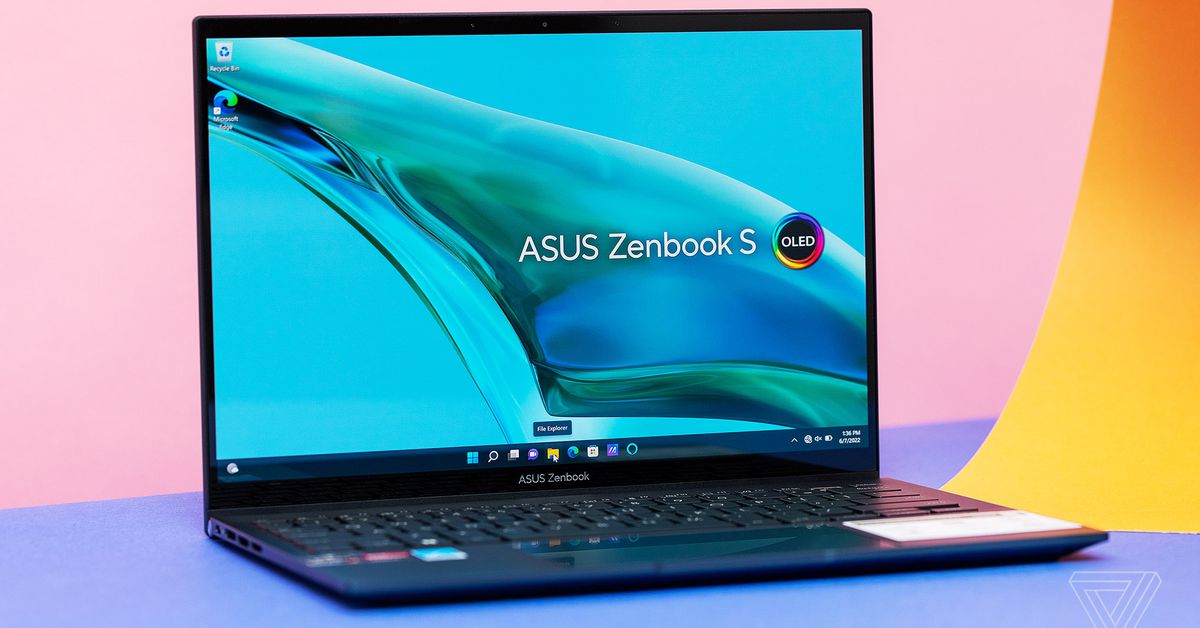At this point, if you’ve used one Asus Zenbook, you’ve used them all. They’re the closest thing Asus has to a MacBook Air competitor, with chassis that are slightly flimsier, touchpads with fancier features, and price tags that are a bit less intimidating. In recent years, they’ve also become one of the cheapest ways to get an OLED screen on a laptop.
But this particular Zenbook, the $1,299 Zenbook S 13 OLED, is also exciting because it’s one of the first devices I’ve gotten to test with AMD’s long-awaited Ryzen 6000 series inside. And while the Zenbook’s chassis is otherwise unremarkable, the chip inside delivers both CPU performance and integrated graphics that are, once again, some of the best you can get in an ultra-thin laptop. That power, combined with the ultra-portability that the Zenbook line is famous for, makes the Zenbook S 13 OLED a very viable MacBook Air alternative for those who are open to Windows.
The Zenbook S 13 does not look especially different from the legions of other Zenbooks out there, but that’s hardly a bad thing. At 2.43 pounds and 0.59 inches thick, it’s one of those devices you can squeeze into even the most packed of backpacks (and one you won’t even feel while it’s in there). While the lid and deck do have a bit of a plasticky feel, there’s very little flex in the lid or keyboard deck. Both were also fairly resistant to collecting fingerprints, which is an issue I’ve had with Zenbooks in the past.
:no_upscale()/cdn.vox-cdn.com/uploads/chorus_asset/file/23613813/akrales_220607_5264_0075.jpg)
Slapping an OLED panel on an ultraportable line notoriously has the danger of making that line exorbitantly expensive and destroying its battery life. That makes this device a breath of fresh air. This OLED touch display, while not quite as vibrant as you might see from the most expensive OLEDs on the market, is still quite nice, reaching a perfectly usable 360 nits in my testing with almost no glare throughout. (And it’s 16:10, affording more vertical space.)
And I still averaged seven hours and 45 minutes of office work on this device with the screen at medium brightness and Battery Saver on (and that was very consistently the time I saw across multiple trials). While I can get a few hours more out of the most recent MacBook Air, it’s still good compared to the various 12th Gen Intel machines I’ve tested this year (as well as all kinds of Intel-powered Zenbooks).
:no_upscale()/cdn.vox-cdn.com/uploads/chorus_asset/file/23615032/akrales_220607_5264_0013.jpg)
:no_upscale()/cdn.vox-cdn.com/uploads/chorus_asset/file/23615032/akrales_220607_5264_0013.jpg)
:no_upscale()/cdn.vox-cdn.com/uploads/chorus_asset/file/23615032/akrales_220607_5264_0013.jpg)
:no_upscale()/cdn.vox-cdn.com/uploads/chorus_asset/file/23615032/akrales_220607_5264_0013.jpg)
Zenbooks are also some of my favorite multimedia machines, and this one works well for that use case. Audio was fairly good, with audible bass and percussion and no distortion at maximum volume. It sounded fairly similar to the MacBook Air in side-by-side testing, with vocals maybe slightly clearer on the Air. There’s a noticeable surround effect — it did feel like my music was surrounding me — and everything’s adjustable in the Dolby Access app. I actually thought the Game and Movie profiles (which prioritize positional accuracy) led to better-sounding and better-surrounding music than the music profile (which felt a bit muted in comparison).
The microphones, which support AI noise cancellation, also didn’t give me any trouble, and people could hear me fine over my apartment’s very loud air conditioner.
:no_upscale()/cdn.vox-cdn.com/uploads/chorus_asset/file/23613811/akrales_220607_5264_0058.jpg)
:no_upscale()/cdn.vox-cdn.com/uploads/chorus_asset/file/23613811/akrales_220607_5264_0058.jpg)
:no_upscale()/cdn.vox-cdn.com/uploads/chorus_asset/file/23613811/akrales_220607_5264_0058.jpg)
:no_upscale()/cdn.vox-cdn.com/uploads/chorus_asset/file/23613811/akrales_220607_5264_0058.jpg)
:no_upscale()/cdn.vox-cdn.com/uploads/chorus_asset/file/23615034/akrales_220607_5264_0069.jpg)
:no_upscale()/cdn.vox-cdn.com/uploads/chorus_asset/file/23615034/akrales_220607_5264_0069.jpg)
:no_upscale()/cdn.vox-cdn.com/uploads/chorus_asset/file/23615034/akrales_220607_5264_0069.jpg)
:no_upscale()/cdn.vox-cdn.com/uploads/chorus_asset/file/23615034/akrales_220607_5264_0069.jpg)
The one significant downside folks should be aware of is port selection. The Zenbook is close to MacBook levels of connectivity now — all you get are three USB-C ports and a headphone jack. I do like that there’s at least one USB-C port on each side (and they are USB-4-ready). Asus includes a USB-C to USB-A adapter in the Zenbook’s box, but needing to use dongles left and right is still a hassle. (There is at least a headphone jack, which some previous OLED Zenbooks have made the unfortunate decision to omit.)
The unit I’m testing (which is the only Zenbook 13 S configuration I’ve been able to find up for preorder) is currently listed for $1,299. It includes the eight-core Ryzen 7 6800U, 1TB of storage, 16GB of RAM, and the 2880 x 1800 OLED display. That’s a very attractive price for those specs, especially considering the screen.
:no_upscale()/cdn.vox-cdn.com/uploads/chorus_asset/file/23613817/akrales_220607_5264_0091.jpg)
:no_upscale()/cdn.vox-cdn.com/uploads/chorus_asset/file/23613817/akrales_220607_5264_0091.jpg)
:no_upscale()/cdn.vox-cdn.com/uploads/chorus_asset/file/23613817/akrales_220607_5264_0091.jpg)
:no_upscale()/cdn.vox-cdn.com/uploads/chorus_asset/file/23613817/akrales_220607_5264_0091.jpg)
The system performed just fine throughout my workday. I used a whole bunch of Chrome tabs on top of all kinds of downloads, apps, and a Zoom call on Battery Saver with no slowdown. I did occasionally feel some warmth on the bottom of the device but never felt any on the palm rests or keyboard deck. (And I didn’t hear the fans unless I had the Performance profile on, and even then, they weren’t obnoxious.) During intense testing, the CPU didn’t pass 96 degrees Celsius (but it did spend a lot of time hovering between 85 and 95 degrees Celsius, which is certainly hot).
The Zenbook completed an export of a five-minute, 33-second 4K video in just over 15 minutes. That does not compare favorably to scores we’ve seen from previous machines that have completed this test, as the latest version of Premiere Pro has given slower scores across the board than previous iterations. Still, it’s worth noting for any aspiring video folks that these kinds of workloads generally aren’t AMD’s strength. The device loses to the M2 MacBook Air (as well as the M1 device) on PugetBench for Premiere Pro, which tests live playback and export time at 4K and 8K, as well as various 12th Gen Intel systems.
:no_upscale()/cdn.vox-cdn.com/uploads/chorus_asset/file/23615036/akrales_220607_5264_0135.jpg)
:no_upscale()/cdn.vox-cdn.com/uploads/chorus_asset/file/23615036/akrales_220607_5264_0135.jpg)
:no_upscale()/cdn.vox-cdn.com/uploads/chorus_asset/file/23615036/akrales_220607_5264_0135.jpg)
:no_upscale()/cdn.vox-cdn.com/uploads/chorus_asset/file/23615036/akrales_220607_5264_0135.jpg)
Outside of those use cases, though, AMD’s integrated graphics are very impressive. I’ve been saying this for years, but there’s not much of a case to be made for buying laptops with entry-level Nvidia MX GPUs when integrated graphics are doing this well.
The system averaged 238fps on League of Legends and 114fps on Rocket League’s maximum settings (all at 1080p resolution). Overwatch was even playable at Epic settings, averaging 52fps on that preset and 83fps on Ultra. Even Shadow of the Tomb Raider was more than playable at the lowest settings, averaging 53fps. (Though it was not playable at the highest settings, averaging 25fps.)
These results are some of the best we’ve seen from integrated graphics in a 13-inch device. They edge out the M2 MacBook Air (not to mention the M1 model), and they beat the Intel 12th Gen Dell XPS 13 Plus as well. Given how much more affordable this device is than both of those laptops, that’s quite impressive (and, frankly, encouraging) to see.
That’s my biggest takeaway from the Zenbook S 13 OLED: AMD still makes some of the best integrated graphics you can get in a laptop of this size.
The eight-core Ryzen 7 chip remains a serious challenger to both Apple and Intel’s best mobile chips that you can find in the 13-inch space. While it doesn’t provide the long battery life that the M2 does, nor does it have Intel’s dominance in creative workloads, it’s still an all-around powerful chip that delivers a really excellent gaming experience without too much external heat. Maybe someday Intel will claw its way back to the top of the chip market — but not this year.
Pair this with the acceptable battery life the Zenbook gave us and the OLED touchscreen, and I’d say it’s an excellent option for anyone who finds premium ultraportables like the MacBook Air to be over budget (or just prefers Windows to macOS).
Credit: Source link

:no_upscale()/cdn.vox-cdn.com/uploads/chorus_asset/file/23613814/akrales_220607_5264_0081.jpg)
:no_upscale()/cdn.vox-cdn.com/uploads/chorus_asset/file/23613815/akrales_220607_5264_0084.jpg)


